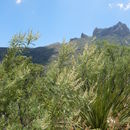Comprehensive Description
provided by North American Flora
Eysenhardtia texana Scheele, Linnaea 21: 462. 1848
A much branched shrub, 2.5-3.5 m. high; stems gray, the young growth more or less canescent with appressed white hairs; leaves 3-6 cm. long, spreading; stipules 2-3 mm. long, brownish, subulate; stipels subulate, less than 0.5 mm. long, shorter than the petiolules, more or less persistent; leaflets 15-31, oblong, 5-11 mm. long, dull-green above, slightly paler beneath, more or less puberulent above and beneath, punctate beneath with minute dark dots, obscurely reticulate above, firm; racemes 3-11 cm. long; bracts 1-2 mm. long, ovate-lanceolate, brown, pubescent, more or less persistent until anthesis; calyx-tube 2-2.2 mm. long, glandular-dotted, more or less canescent-puberulent, slightly ridged, split much more deeply (but not to the middle) on the posterior side; lobes 0.6-0.9 mm. long, obtusish to acute, finely pubescent; petals 4-5 mm. long, membranous, more than twice as long as the calyx, the standard slightly broader, rounded to slightly emarginate; style 2.5-3 mm. long, pubescent, slightly upcurved at the apex, the gland at the curve short and thick, conspicuous, reddish-brown; pods 7-10 mm. long, 1.7— 2.5 mm. wide, thickened, greenish-brown, glabrous, punctate distally with evident glands, more or less strongly upcurved throughout, at maturity ascending, on pedicels 0.5-1 mm. long; seed 3.2-3.7 mm. long, lanceolate to obovoid, thickened, very smooth, brown, with a broad basal lobe, filling three fifths to two thirds the length of the pod.
Type locality: New Braunfels, Texas.
Distribution: Dry hillsides and canons, southern Texas to Coahuila and Tamaulipas.
- bibliographic citation
- Per Axel Rydberg. 1919. (ROSALES); FABACEAE; PSORALEAE. North American flora. vol 24(1). New York Botanical Garden, New York, NY
Comprehensive Description
provided by North American Flora
Eysenhardtia angustifolia Pennell, sp. nov
A much branched small tree, 3-4 m. high ; stems grayish-brown, the young growth canescent with whitish incurved to appressed hairs; leaves 8-9 cm. long, spreading; stipules 3-4 mm. long, grayish, filiform; stipels subulate, less than 0.5 mm. long, shorter than the petiolules, deciduous; leaflets 37-47, narrowly oblong, 10-12 mm. long, dull-green above, slightly paler beneath, puberulent above and beneath, punctate beneath with small nearly black dots, reticulate above, firm; racemes 4-7 cm. long; bracts 1-2 mm. long, ovate-acuminate, brown, pubescent, more or less persistent through anthesis; calyx-tube 2.3-3 mm. long, glandular-dotted, finely canescent, ridged, split slightly more deeply on the posterior side; lobes 0.6-0.8 mm. long, obtusish, pubescent; petals 4-4.5 mm. long, membranous, from less than twice to twice as long as the calyx, the standard broader, broadly emarginate; style 2.5-3 mm. long, pubescent, slightly upcurved at the apex, the gland at the curve large, conspicuous, paleyellowish; pods 7-8 mm. long, 2-2.2 mm. wide, slightly thickened, greenish-brown, glabrous, punctate distally with relatively large glands, slightly upcurved at the apex, at maturity ascending on pedicels 0.5-0.6 mm. long; seed 3.3 mm. long, lanceolate, thickened, very smooth, olive-brown, with a broad basal lobe, filling one half to three fifths the length of the pod.
Type collected in flower and fruit, at Sanderson [Terrill County], Texas, September 29, 1911, E. O. Wooion (U. S. Nat. Herb.).
Distribution: Trans-Pecos region of Texas.
- bibliographic citation
- Per Axel Rydberg. 1919. (ROSALES); FABACEAE; PSORALEAE. North American flora. vol 24(1). New York Botanical Garden, New York, NY
Physical Description
provided by USDA PLANTS text
Perennial, Trees, Shrubs, Woody throughout, Stems woody below, or from woody crown or caudex, Nodules present, Stems erect or ascending, Stems 1-2 m tall, Stems gr eater than 2 m tall, Plants gland-dotted or with gland-tipped hairs, Stems solid, Stems or young twigs sparsely to densely hairy, Leaves alternate, Leaves petiolate, Stipules inconspicuous, absent, or caducous, Stipules setiform, subulate or acicular, Stipules deciduous, Stipules free, Leaves compound, Leaves odd pinnate, Leaf or leaflet margins entire, Leaflets opposite, Stipels present at base of leaflets, Leaflets 10-many, Leaves glabrous or nearly so, Inflorescences spikes or spike-like, Inflorescence axillary, Inflorescence terminal, Bracts very small, absent or caducous, Bracteoles present, Flowers sessile or nearly so, Flowers zygomorphic, Calyx 5-lobed, Calyx gland-dotted or with glandular spot, Calyx glabrous, Petals separate, Petals clawed, Petals white, Banner petal narrow or oblanceolate, Wing petals narrow, oblanceolate to oblong, Keel tips obtuse or rounded, not beaked, Stamens 9-10, Stamens diadelphous, 9 united, 1 free, Filaments glabrous, Style terete, Styl e hairy, Fruit a legume, Fruit unilocular, Fruit indehiscent, Fruit oblong or ellipsoidal, Fruit exserted from calyx, Fruit glabrous or glabrate, Fruit gland-dotted or with gland-tipped hairs, Fruit 1-seeded, Seeds ovoid to rounded in outline, Seed surface smooth, Seeds olive, brown, or black.
Eysenhardtia texana
provided by wikipedia EN
Eysenhardtia texana, commonly known as Texas kidneywood, bee-brush, or vara dulce,[2] is a species of small flowering tree in the legume family, Fabaceae. It is found from south-central Texas south to northern San Luis Potosí in the Rio Grande Valley region of south Texas–Northeastern Mexico, and the species ranges into the eastern Chihuahuan Desert areas of Coahuila.[3]
Distribution
The contiguous range of Texas kidneywood covers the three neighboring Mexican states of Coahuila, Nuevo Leon, and Tamaulipas in northeast Mexico, the Rio Grande valley, from Big Bend southeastwards, but not the coastal Gulf of Mexico areas, only 25–50 miles inland. Part of the range extends southwards into extreme northern San Luis Potosí,[3] and some isolated locales towards east-central and southern Texas.
References

- license
- cc-by-sa-3.0
- copyright
- Wikipedia authors and editors
Eysenhardtia texana: Brief Summary
provided by wikipedia EN
Eysenhardtia texana, commonly known as Texas kidneywood, bee-brush, or vara dulce, is a species of small flowering tree in the legume family, Fabaceae. It is found from south-central Texas south to northern San Luis Potosí in the Rio Grande Valley region of south Texas–Northeastern Mexico, and the species ranges into the eastern Chihuahuan Desert areas of Coahuila.
- license
- cc-by-sa-3.0
- copyright
- Wikipedia authors and editors

